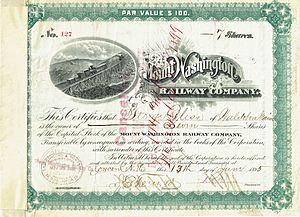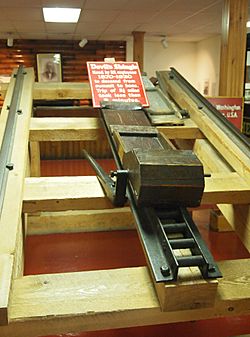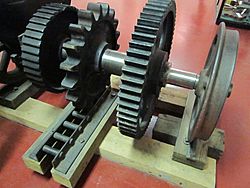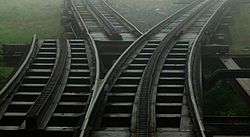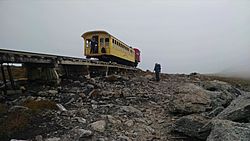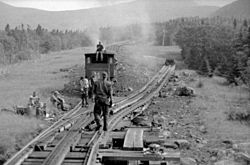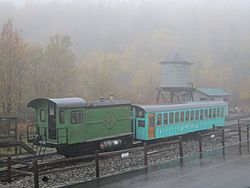Mount Washington Cog Railway facts for kids
Quick facts for kids Mount Washington Cog Railway |
|
|---|---|
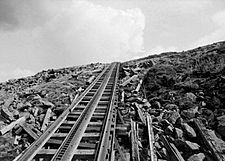
Track with rack
|
|
| Overview | |
| Locale | Coos County, New Hampshire, U.S. |
| History | |
| Opened | 1868 |
| Technical | |
| Line length | 3 miles (4.8 km) |
| Rack system | Marsh rack system |
| Track gauge | 4 ft 8 in (1,422 mm) |
The Mount Washington Cog Railway, also known as the Cog, is a special train line in New Hampshire, United States. It was the world's very first "cog railway" built to climb a mountain. A cog railway uses a special gear system, like a ladder on the track, to help trains climb very steep hills.
The Cog Railway is still running today, taking visitors up Mount Washington, which is a very tall mountain. It's the second steepest cog railway in the world! Only one in Switzerland is steeper. The trains use both old-fashioned steam engines and newer engines that run on biodiesel fuel.
The track is about 3 miles (4.8 km) long. It starts at about 2,700 feet (823 m) above sea level and goes almost to the mountain's top, which is 6,288 feet (1,917 m) high. The train goes up slowly, at about 2.8 miles per hour (4.5 km/h), and comes down a bit faster, at 4.6 miles per hour (7.4 km/h). Steam trains take about 65 minutes to go up, while the biodiesel trains can do it in just 36 minutes!
Most of the railway is in a place called Thompson and Meserve's Purchase. The very top part is in Sargent's Purchase.
Contents
History of the Cog Railway
How the Idea for the Railway Started
The idea for this amazing railway came from a man named Sylvester Marsh. He grew up in Campton. In 1852, Marsh was climbing Mount Washington and thought, "Wouldn't it be great if a train could go up here?" At first, people thought his idea was crazy!
There's a story that the state government allowed him to build it because they thought it was impossible. They figured he'd spend his own money locally, which would help the area, and no harm would come from trying something so wild. One person even joked that Marsh should be given permission to build a railway to the Moon!
Building the Railway: A Big Challenge
Marsh got official permission to build the railway on June 25, 1858. However, the American Civil War put his plans on hold until 1866. He didn't give up! He built a small test train and a short piece of track to show how it would work. Then, he found people to invest money, and the Mount Washington Railway Company was formed in 1866. Construction began soon after. The railway's path followed an old mountain trail.
Even though it wasn't finished, the first passengers rode the train on August 14, 1868. The railway finally reached the summit in July 1869. The first trains had tall, upright boilers, like many old steam engines. These boilers could tilt to stay straight up as the train climbed the steep mountain. Later, trains used slanted boilers that stayed nearly flat on the tracks.
In August 1869, President Ulysses S. Grant even took a ride on the Cog Railway to the top of Mount Washington!
Who Has Run the Cog Railway?
Sylvester Marsh passed away in 1884. The railway was then managed by different railroad companies. From 1868 to 1910, the trains burned wood for fuel. In 1910, they switched to using coal.
In 1931, Colonel Henry N. Teague bought the Cog Railway. After he died in 1951, Arthur S. Teague took over and later owned it. When Arthur died in 1967, his wife, Ellen Crawford Teague, became the owner. She was the first woman president of a railway in the world!
In 1983, Mrs. Teague sold the railway to a group of New Hampshire business people. From 1986 to 2017, Wayne Presby and Joel Bedor owned and controlled the railway. They worked hard to make the railway better, with help from an engineer named Al LaPrade. The Cog Railway has been running continuously since 1869, except for short breaks during the World Wars.
In 2008, the Cog Railway started using its first diesel train. This helped save money because diesel trains could make more trips for the same cost as one steam train trip.
In 2016, there was a plan to build a hotel along the railway line, but many people didn't like the idea because of its location on the mountain. So, the plan was stopped.
In 2017, Wayne Presby became the sole owner of the railway. He started new projects, like replacing all the tracks.
Workers' "Devil's Shingles"
When the railway was being built, workers found a fun way to get up and down the mountain quickly. They made special wooden boards called "Devil's shingles." These boards were about 35 inches (90 cm) long and 10 inches (25 cm) wide. They fit over the cog track and had handles.
Workers could slide down the mountain on these boards in about 15 minutes! The fastest recorded time was an amazing 2 minutes and 45 seconds, which is over 60 miles per hour (100 km/h)!
However, these "shingles" were very dangerous. After an employee died in an accident, they were banned in 1908. But some sources say workers still used them secretly until the 1920s. Later, the track design was changed so the old braking system on the shingles wouldn't work anymore.
How the Cog Railway Works
Building the Trains
The Mount Washington Cog Railway designs and builds all of its own trains and passenger cars. This happens at their workshops right at the base of Mount Washington.
Each train has a locomotive (the engine) that pushes a single passenger car up the mountain. When coming down, the locomotive goes in reverse. Both the engine and the car have special braking systems to keep them safe on the steep slopes. Older trains used a "ratchet and pawl" system, like a gear with a clicker, to stop them from rolling backward. Newer trains use modern "sprag clutches" and "disc brakes." Many of the older locomotives were built by the Manchester Locomotive Works.
The special "rack" rail system used on the track was invented by Sylvester Marsh himself. It looks like a ladder with open rungs. The teeth of the train's "cog wheel" fit into these rungs. This design is great because snow and dirt can fall through the rack instead of getting stuck. A similar system was invented in Switzerland around the same time by an engineer named Niklaus Riggenbach.
Passing Other Trains
For a long time, only one train could go up or down the Mount Washington Cog Railway at a time. There was no way for trains to pass each other. In 1941, a special kind of switch was invented. This allowed two side tracks, called "sidings," to be added. These sidings were long enough for two trains coming down to wait while trains going up continued to the summit. This meant more trips could be made each day.
In 2004, the railway improved its lower passing area. They added a new 1,800-foot (549 m) loop with automatic switches. These switches are powered by batteries that get recharged by solar panels! This allows trains going up and down to pass each other smoothly.
In 2014, work began on another switch at the very top of Mount Washington. When finished, this will allow trains to pass each other at the summit too.
Modern Engines
In 2008, the railway started building its first diesel locomotive that runs on biodiesel fuel. By 2013, they had built five of these new engines. A sixth biodiesel engine was finished in 2016.
Modern Operations
Most trips on the Cog Railway go between the main station at the base of the mountain and the station at the summit.
From 2003 to 2006, there were special "ski trains." These trains stopped at a middle station, and passengers could then ski down to the base.
The Cog Railway track crosses over three hiking trails, including the Gulfside Trail, which is part of the famous Appalachian Trail.
You can get to the base station by car using a few different roads. One scenic route, Jefferson Notch Road, is a narrow dirt road with sharp turns. It climbs high up the mountain before going down to the base road. This road is closed in winter. Another route from Crawford Notch is also closed in winter. However, since trains started running all winter in 2004–2005, the main Cog Base Road is plowed and kept clear for visitors and workers.
Environmental Concerns
The steam locomotives on the railway create a lot of smoke, which some people call "Cog Smog." The railway has a special permission that allows it to continue using these older steam engines.
Each 3-mile (4.8 km) steam train ride burns about 1 ton (907 kg) of coal and uses 1,000 US gallons (3,785 L) of water.
In 2008, one steam engine was changed to burn oil, but this didn't work out well. So, the railway started building its own diesel locomotives instead. Since 2008, they have built five more diesel engines. These new diesel trains run on B20, which is a blend of 20% biodiesel fuel. The company built these new diesel engines to reduce the smoke from the coal trains, lower pollution, and allow passengers more time at the summit.
Each 3-mile (4.8 km) diesel train ride burns about 18 US gallons (68 L) of B20 fuel.
The trains push passenger cars that can hold up to 70 people. The Cog Railway also has eight older wooden passenger cars.
Locomotives
| Number | Name | Image | Builder | Type | Date | Status | Notes |
|---|---|---|---|---|---|---|---|
| 1 | Old Peppersass | 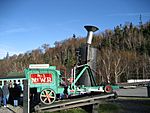 |
Campbell, Whittier and Company | Steam | 1866 | On display | This was the world's first cog locomotive! It was first called Hero. It stopped running in 1878. It was fixed up in 1929 but then crashed. After the crash, it was put back together and is now on display at Marshfield Station. |
| 1 | Mt. Washington | Manchester Locomotive Works | Steam | 1883 | In storage | This engine was first number 7, called Falcon. It was renumbered to 1 after being rebuilt following a fire in 1895. It was renamed Mt. Washington after 1931. It is currently stored and not in use. | |
| 2 | Ammonoosuc | 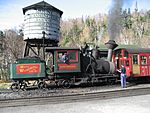 |
Manchester Locomotive Works | Steam | 1875 | Operational | This engine was originally number 4, called Atlas. It was renumbered to 2 after being rebuilt following the 1895 fire. It was named Ammonoosuc after 1931. It is still running today! |
| 3 | Agiocochook | 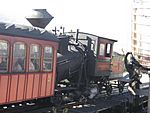 |
Manchester Locomotive Works | Steam | 1883 | In storage | This engine was originally built for another railway. It was involved in a fatal accident in 1967. It was renamed Agiocochook in the mid-1990s. It last ran in 2009 and is currently stored outside the engine shops. |
| 4 | Summit | 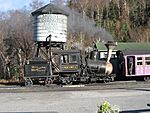 |
Manchester Locomotive Works | Steam | 1883 | On display | This engine was also built for another railway before coming to Mount Washington. It was renamed Chocorua around 2000. In 2007, it was renumbered and renamed Moosilauke. It stopped running after the 2009 season. In 2013, it was given to the village of Twin Mountain and is now on display there. |
| 6 | Kancamagus |  |
Manchester Locomotive Works | Steam | 1874 | In storage | This engine was first built with an upright boiler. It was rebuilt in 1878 with a horizontal boiler. It was renamed Kancamagus around 2000. It last ran in 2010 and is currently stored inside the engine shops. |
| 8 | Moosilauke | 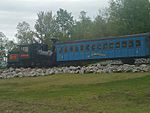 |
Mount Washington Cog Railway Shop | Steam | 1983 | In storage | This engine was built in 1983 at the Cog Shop and was the newest steam locomotive in the world at the time. It was named Tip-Top and then Moosilauke. It last ran in 2006. Its parts are now stored, and its cab and tender are on engine #4. |
| 9 | Waumbek |  |
Manchester Locomotive Works | Steam | 1908 | Operational | This was the first engine with a horizontal boiler where the cab was on the same level as the boiler. It briefly ran on biodiesel but was changed back to coal. It is still running today! |
| 10 | Col. Teague | 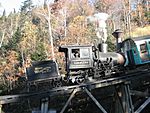 |
Mount Washington Cog Railway Shop | Steam | 1972 | On display | This engine uses a larger, welded boiler. It was briefly converted to burn oil but then changed back to coal. It last ran in 2009. Since 2015, it has been on display at the entrance to the railway. |
| M-1 | Wajo Nanatassis | 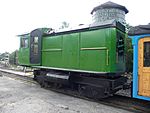 |
Mount Washington Cog Railway Shop | Diesel | 2008 | Operational | This was the first diesel-hydraulic locomotive built by the railway. It runs on biodiesel (B20). |
| M-2 | Algonquin | 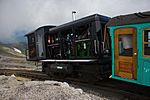 |
Mount Washington Cog Railway Shop | Diesel | 2009 | Operational | This is the second diesel-hydraulic locomotive. It runs on biodiesel (B20). |
| M-3 | Abenaki |  |
Mount Washington Cog Railway Shop | Diesel | 2009 | Operational | This is the third diesel-hydraulic locomotive. It runs on biodiesel (B20). |
| M-4 | Agiocochook | 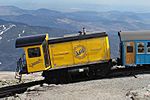 |
Mount Washington Cog Railway Shop | Diesel | 2010 | Operational | This is the fourth diesel-hydraulic locomotive. It runs on biodiesel (B20). |
| M-5 | Metallak | 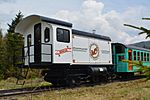 |
Mount Washington Cog Railway Shop | Diesel | 2013 | Operational | This is the fifth diesel-hydraulic locomotive. It runs on biodiesel (B20). |
| M-6 | LaPrade | Mount Washington Cog Railway Shop | Diesel | 2016 | Operational | This is the sixth diesel-hydraulic locomotive. It runs on biodiesel (B20). | |
| M-7 | Kenison | Mount Washington Cog Railway Shop | Diesel | 2019 | Operational | This is the seventh diesel-hydraulic locomotive. It runs on biodiesel (B20). |
Images for kids



